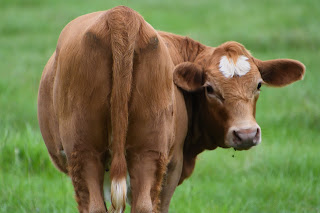Are there ways of raising beef that are better for the planet?
By Michael Coppola and Nancy Lazar
Some proponents of continuing to eat beef at the rate that we do now say that there is a greener, less greenhouse gas producing way of raising cattle. It is referred to as grass-fed.
Comparing grass-fed beef to factory farming methods we find both graze the cattle for around a year; however the difference between the two begins when the rancher wants to ready his product for market. The industry calls this process “finishing” getting the animal at the optimal weight to slaughter.
To be called grass-fed, a year old calf will be allowed to continue grazing for another year to year and a half. For grass fed cattle more land is required during both periods, as much as three times the acreage. But on a factory farm the cattle will be moved to pens and fed grains, corn, and other feeds for around six months to fatten them up faster. The result will be grain fed cattle that reach a higher weight than the grass-fed cattle at the time they are sold to be slaughtered.
A review of multiple articles describing both sides of the argument for these two methods of raising cattle has led me to a few conclusions. When current best practices are adhered to (these are practices involving feed sourcing, manure recycling, field rotation etc.) less greenhouse gasses (GHG’s) are produced.
Another factor to consider is the larger amount of land required to raise grass-fed cattle. This type of farming is only practical on a large scale in countries that have vast amounts of fields available. Ninety percent of all grass-fed labeled beef in the US is imported. All imported beef must pass through US inspection facilities and once it does, it can be labeled a US product so it is very hard to know exactly where your beef originated. Additionally, they can be fed pellets made from grass and still be considered grass-fed. Of note, there are no FDA standards for labeling the beef grass-fed.
In conclusion, grass-fed cattle do not reduce the amount of GHG’s. In fact, both methods when done with the best practices still use more land than is actually available to provide the amount of cattle based food to support a growing world population. The bottom line is that eating beef is still not a way forward if we want to reduce the amount of methane contributing to Global Warming. When we change to a diet based on plants we will get the greatest reduction in Greenhouse gas effects.





Comments
Post a Comment